1. Introduction
A fiber laser is a type of laser that utilizes a fiber doped with rare earth or special elements like bismuth, thulium, erbium, etc. as the gain medium. Its core structure consists of a pump source, a fiber resonator, and an output coupling system. Since the emergence of lasers in the 1960s, fiber lasers have gradually emerged as a crucial research area in the field of laser technology. This is attributed to their high efficiency, high beam quality, excellent heat dissipation capabilities, and flexible wavelength tunability. As a result, they have been extensively applied in industrial, medical, communication, and scientific research domains.
Research on fiber lasers began in the 1960s, almost simultaneously with the development of semiconductor lasers and solid-state lasers. In 1961, Elias Snitzer first proposed and demonstrated a neodymium-doped (Nd³⁺) fiber laser. Nevertheless, due to the limitations of fiber manufacturing technology and pump sources at that time, its performance was far from meeting practical requirements. It was not until the 1980s, when low-loss quartz fiber manufacturing technology matured and semiconductor laser (LD) pumping technology advanced, that fiber lasers began to enter a stage of rapid development.
In the 1990s, traditional rare-earth ion-doped fiber lasers emerged as a prominent research focus. Among them, ytterbium-doped (Yb³⁺), thulium-doped (Tm³⁺), and erbium-doped (Er³⁺) fiber lasers were at the core of research endeavors. In recent years, however, the wavelength range of traditional rare-earth ion-doped fiber lasers has been constrained by the energy level structure of rare-earth ions. This limitation poses challenges in covering certain spectral bands, such as the 1200 - 1500 nm range. Consequently, researchers have initiated explorations into novel types of doped fibers. Bismuth ions, as a green and non-toxic main-group heavy metal element, exhibit unique properties. Due to their electronic structure, they are highly sensitive to the crystal field environment and can emit fluorescence across a wide spectrum from ultraviolet to near-infrared. This characteristic endows bismuth ions with significant application potential in the 1150 - 1800 nm spectral region [1, 2].
Bismuth-doped fiber lasers exhibit substantial applications in the 1150 nm band and find utility in diverse fields including biomedical imaging, spectral analysis, and optical communication. Owing to the broad fluorescence spectrum and high quantum efficiency of bismuth-doped fibers, they have garnered extensive attention in recent years. In 2025, Zhai reported a single-mode BGSF continuous laser with continuous tunability ranging from 1425 to 1475 nm [3], while Dianov achieved, for the first time, bismuth-doped fiber output spanning from 1470 to 1550 nm. To date, experimental results have demonstrated that the wavelength range of bismuth-doped fiber lasers can cover from 1100 nm to 1800 nm [4].
In this study, numerical simulations and emulations of the 1150 - nm bismuth - doped fiber laser model are conducted to acquire the laser emission power curve with a central wavelength of 1150 nm. Subsequently, the physical properties of the bismuth - doped fiber laser at this wavelength are deliberated.
2. Models and methods
This study conducts a numerical simulation study of a 1150nm bismuth-doped fiber laser based on a rate equation model and a boundary value problem-solving approach.
2.1. Model construction
The 1150nm bismuth-doped fiber laser is a Bi+ ion-based luminescent system [5-8], and the system is a three-level system, so the simulation model is built according to the three-level system. The rate equation of the three-level system is as follows:
The energy level diagram of the three-level system is shown in Figure 1:
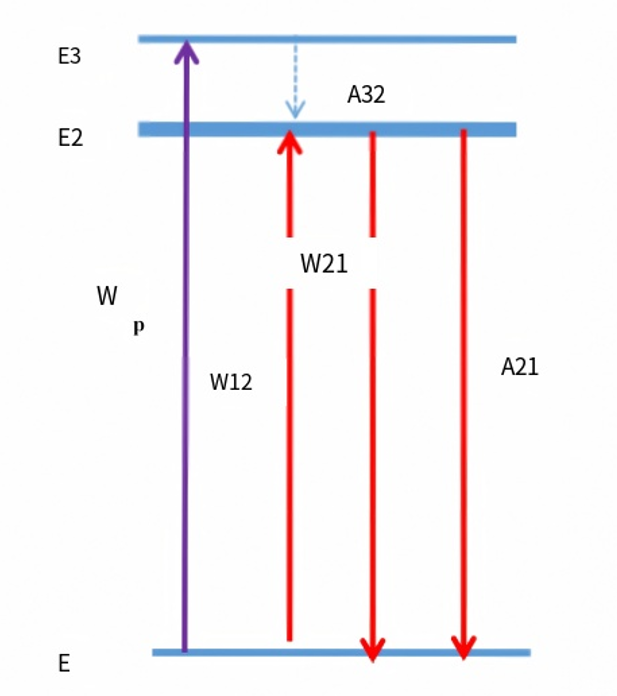
Subsequently, the output power of the fiber laser was calculated based on the power propagation equation, the pump power calculation equation, and the output power equation of the fiber laser. The output power of the fiber laser is calculated by the following equations:
Designing the simulation model of the three-level system fiber laser based on the above equations is the most important step in the design experiment of this paper.
2.2. Data lookup
Search for a series of data on the ion based on the required medium to obtain pump light wavelength λp=532nm for a 1150nm bismuth-doped laser, and the absorption and emission cross-section data of Bi+ are shown in Figure 2 [6,7,9,10].
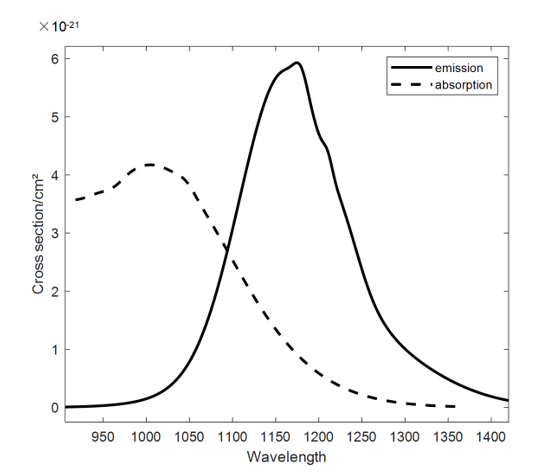
The data required for other experiments are shown in Table 1 .
|
Parameters |
value |
Units |
|
Lambda. |
1.15 x 10 |
m2 |
|
Lambda. |
5.32 x 10 |
m2 |
|
tau |
6.3 x 10 |
s |
|
sigma |
1 x 10 |
m2 |
|
sigma |
6 x 10 |
m2 |
|
Alpha. |
4 x 10 |
m-1 |
|
Alpha. |
2 x 10 |
m-1 |
|
R1 |
0.99 |
|
|
R2 |
0.35 |
3. Experimental results
3.1. Steady-state power characteristics analysis
Through the architecture of the laser model and the collection of data, this experiment successfully simulated the pumping power and output power of the bismuth-doped fiber laser at 1150nm, as shown in Figure 2, and the power distribution diagram under the above conditions is shown in Figure 3.
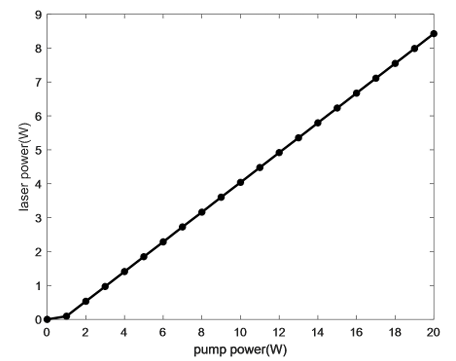
Figure 3 shows the curve of output power of the bismuth-doped fiber varying with pump power. When the pump power is less than 1W, the output power is close to 0 due to incomplete particle number inversion.
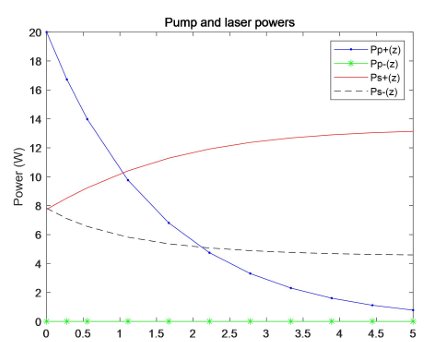
Figure 4 shows that the pump light input decreases exponentially and there is no backpumping, which is a typical output of a bismuth-doped fiber laser system.
3.2. Fiber length optimization
In this study, the optimal solution for the fiber length set in this experiment was obtained by setting different fiber lengths and comparing their threshold power and opto-optical conversion efficiency at different lengths. The threshold power distribution is shown in Figure 5.

As shown in Figure 5, the threshold power increases with the length of the fiber, but the optimal length of the fiber cannot be determined by the threshold power alone. It needs to be determined in combination with the optical-optical conversion power, as shown in Figure 6.
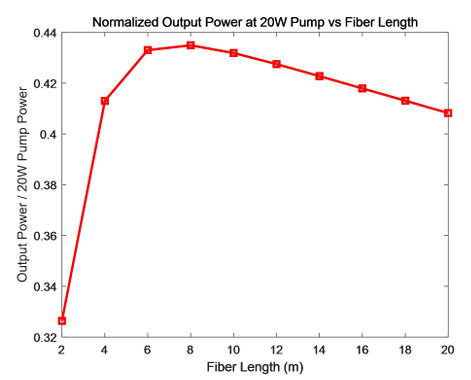
As shown in Figure 6, the conversion efficiency increases with the length of the fiber from 0 to 8m, reaches its maximum at 8m, and decreases from 8 to 20m. Therefore, in combination with the threshold power and conversion efficiency, this paper concludes that the optimal fiber length in the fiber laser simulation system designed in this paper is 8m.
The experiment constructed a simulation model of a 1150nm bismuth-doped fiber laser based on a three-level fiber laser system, which solved the problem of poor transmission performance of traditional rare earth ion lasers in this band and has some reference value. Ytterbium-doped and thulium-doped fiber lasers can also output lasers in this band, but the process is more complex. Bismuth ions have a wide range of light emission and are of very high research value. 1150nm bismuth-doped lasers can be used in laser medical fields to meet the application requirements of orange-yellow lasers; It can also serve as a pump source for mid-infrared lasers; It can also be used in the biomedical field for laser surgery, tissue cutting, etc., with broad application prospects.
4. Conclusions
This study reveals the dynamic characteristics of 1150nm bismuth-doped fiber lasers through numerical simulation,
Based on the formula equation of the three-level system, a simulation model of the 1150nm bismuth-doped fiber laser was constructed and its power characteristic curve was successfully output, which conforms to the linear output characteristic of the fiber laser after reaching the threshold power. By changing the parameter of fiber length, the optimal fiber length for the 1150nm band bismuth-doped fiber laser can be obtained by combining the threshold power and the optical-optical conversion efficiency.
The future research directions are also quite extensive. First, optimize the bismuth doping concentration to further enhance the gain characteristics and laser output power of the fiber. Second, adjust the fiber matrix to explore the matrix components that are most suitable for bismuth-doped fiber. Finally, this experiment did not consider the influence of temperature on the Bi+ ion energy level structure. In subsequent experiments, the performance characteristics of bismuth-doped fiber lasers at different temperatures can be considered.
References
[1]. Wu, S.P. and Chen, W. (2025) Research Progress of Bismuth-Doped Fibers and Their Applications. Laser & Optoelectronics Progress, 1-15. http: //kns.cnki.net/kcms/detail/31.1690.TN.20250611.1639.036.html
[2]. Dyalov, Y. (2020) History, Development and Prospects of Bismuth-Doped Fibers. Optics & Optoelectronic Technology, 18, 1-4. DOI: 10.19519/j.cnki.1672-3392.2020.01.001
[3]. Zhai, Z. and Sahu, J.K. (2024) All-Fiber E+S Band Continuously Tunable Bismuth-Doped Germanosilicate Fiber Laser. Optics Letters, 50, 141-144.
[4]. Dianov, E.M., Firstov, S.V., Khopin, V.F., et al. (2009) Bi-Doped Fibre Lasers Operating in the Range 1470-1550 nm. Quantum Electronics, 39, 299.
[5]. Dianov, E.M., Dvoyrin, V.V., Mashinsky, V.M., et al. (2005) CW Bismuth Fibre Laser. Quantum Electronics, 35, 1083-1084.
[6]. Yoo, S., Kalita, M.P., Nilsson, J., et al. (2009) Excited State Absorption Measurement in the 900-1250 nm Wavelength Range for Bismuth-Doped Silicate Fibers. Optics Letters.
[7]. Shi, C.J. (2021) Preparation and Amplification Performance Research of Bismuth-Doped Optical Fibers. Huazhong University of Science and Technology. DOI: 10.27157/d.cnki.ghzku.2021.000769
[8]. Ren, T.Y. (2018) Research on the Characteristics of Low-Valence Bismuth Luminescence Centers in Bismuth-Doped Optical Fibers. Beijing University of Posts and Telecommunications.
[9]. Liu, P. (2016) Research on the Characteristics and Applications of Bismuth-Doped Optical Fibers. Huazhong University of Science and Technology.
[10]. Cheng, M.S., Yan, B.B., Sang, X.Z., et al. (2015) Research on the Broadband Optical Amplification Characteristics of Bismuth-Doped Optical Fibers. Chinese Journal of Lasers, 42, 125-131.
Cite this article
Tong,W. (2025). Research on Bismuth-Doped Fiber Lasers in the 1150-1200nm Band. Applied and Computational Engineering,182,69-76.
Data availability
The datasets used and/or analyzed during the current study will be available from the authors upon reasonable request.
Disclaimer/Publisher's Note
The statements, opinions and data contained in all publications are solely those of the individual author(s) and contributor(s) and not of EWA Publishing and/or the editor(s). EWA Publishing and/or the editor(s) disclaim responsibility for any injury to people or property resulting from any ideas, methods, instructions or products referred to in the content.
About volume
Volume title: Proceedings of CONF-FMCE 2025 Symposium: AI and Machine Learning Applications in Infrastructure Engineering
© 2024 by the author(s). Licensee EWA Publishing, Oxford, UK. This article is an open access article distributed under the terms and
conditions of the Creative Commons Attribution (CC BY) license. Authors who
publish this series agree to the following terms:
1. Authors retain copyright and grant the series right of first publication with the work simultaneously licensed under a Creative Commons
Attribution License that allows others to share the work with an acknowledgment of the work's authorship and initial publication in this
series.
2. Authors are able to enter into separate, additional contractual arrangements for the non-exclusive distribution of the series's published
version of the work (e.g., post it to an institutional repository or publish it in a book), with an acknowledgment of its initial
publication in this series.
3. Authors are permitted and encouraged to post their work online (e.g., in institutional repositories or on their website) prior to and
during the submission process, as it can lead to productive exchanges, as well as earlier and greater citation of published work (See
Open access policy for details).
References
[1]. Wu, S.P. and Chen, W. (2025) Research Progress of Bismuth-Doped Fibers and Their Applications. Laser & Optoelectronics Progress, 1-15. http: //kns.cnki.net/kcms/detail/31.1690.TN.20250611.1639.036.html
[2]. Dyalov, Y. (2020) History, Development and Prospects of Bismuth-Doped Fibers. Optics & Optoelectronic Technology, 18, 1-4. DOI: 10.19519/j.cnki.1672-3392.2020.01.001
[3]. Zhai, Z. and Sahu, J.K. (2024) All-Fiber E+S Band Continuously Tunable Bismuth-Doped Germanosilicate Fiber Laser. Optics Letters, 50, 141-144.
[4]. Dianov, E.M., Firstov, S.V., Khopin, V.F., et al. (2009) Bi-Doped Fibre Lasers Operating in the Range 1470-1550 nm. Quantum Electronics, 39, 299.
[5]. Dianov, E.M., Dvoyrin, V.V., Mashinsky, V.M., et al. (2005) CW Bismuth Fibre Laser. Quantum Electronics, 35, 1083-1084.
[6]. Yoo, S., Kalita, M.P., Nilsson, J., et al. (2009) Excited State Absorption Measurement in the 900-1250 nm Wavelength Range for Bismuth-Doped Silicate Fibers. Optics Letters.
[7]. Shi, C.J. (2021) Preparation and Amplification Performance Research of Bismuth-Doped Optical Fibers. Huazhong University of Science and Technology. DOI: 10.27157/d.cnki.ghzku.2021.000769
[8]. Ren, T.Y. (2018) Research on the Characteristics of Low-Valence Bismuth Luminescence Centers in Bismuth-Doped Optical Fibers. Beijing University of Posts and Telecommunications.
[9]. Liu, P. (2016) Research on the Characteristics and Applications of Bismuth-Doped Optical Fibers. Huazhong University of Science and Technology.
[10]. Cheng, M.S., Yan, B.B., Sang, X.Z., et al. (2015) Research on the Broadband Optical Amplification Characteristics of Bismuth-Doped Optical Fibers. Chinese Journal of Lasers, 42, 125-131.









